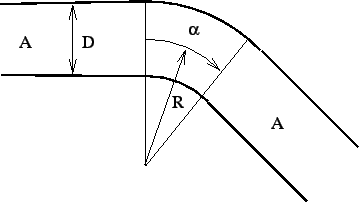 |
A bend (Figure 119) is characterized by head
losses
![]() of the form:
of the form:
 |
(133) |
where ![]() is a head loss coefficient depending on the bend angle
is a head loss coefficient depending on the bend angle ![]() and the ratio of the bend radius to the pipe diameter
and the ratio of the bend radius to the pipe diameter ![]() ,
,
![]() is the mass flow, g is the gravity acceleration and
is the mass flow, g is the gravity acceleration and ![]() is the
liquid density.
is the
liquid density. ![]() is the cross section of the pipe. Values for
is the cross section of the pipe. Values for ![]() can be found in file ``liquidpipe.f''.
can be found in file ``liquidpipe.f''.
The following constants have to be specified on the line beneath the *FLUID SECTION, TYPE=PIPE BEND card:
![]() denotes the roughness of the pipe:
denotes the roughness of the pipe: ![]() applies to an extremely
smooth pipe surface,
applies to an extremely
smooth pipe surface, ![]() to a very rough surface. The gravity acceleration must be specified by a gravity type
*DLOAD card defined for the elements at stake. The material
characteristic
to a very rough surface. The gravity acceleration must be specified by a gravity type
*DLOAD card defined for the elements at stake. The material
characteristic ![]() can be defined by a
*DENSITY
card.
can be defined by a
*DENSITY
card.
Example files: centheat1, pipe.